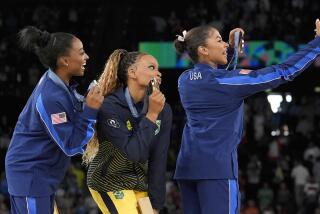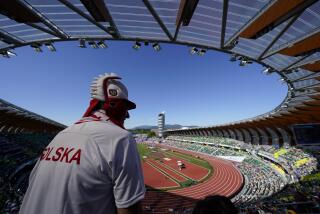National Agenda : Populous India No Contender When It Comes to Sports : The huge country must overcome hurdles of poverty, bureaucracy and politics to compete effectively, critics say.
- Share via
PUNE, India — The 20,000-seat stadium was brand new, the weather dry and sunny, picture perfect for the National Games. On the eight-lane polyurethane track, India’s fastest men pushed their feet against the blocks. “Take your marks, get set . . . ,” the starter barked.
Then--nothing but a dry click.
Half a dozen times, officials lined the perspiring and increasingly frustrated runners up for the 100-meter race, and just as often, the starter’s pistol refused to fire. While harried stewards searched for a new gun, longer-distance events were set off with a whistle.
When another pistol was found, it was wide-striding Rajeev Balakrishnan, 22, who finished first, his finger triumphantly pointing at the sky. But the time clocked by the electrical engineering student from Iowa State University, 10.78 seconds, was almost a half-second over the national record for the 100 set 21 years earlier.
Is any more evidence needed that something is seriously the matter with Indian sports? “Why we have fallen so low is a basic question that every Indian is asking,” said Narotam Puri, a celebrated New Delhi sports commentator and physician. “Everyone is crying himself hoarse, because . . . we have fallen on hard times.”
These days sports are much more than physical recreation or strenuous entertainment. They are a widely accepted indicator of a country’s development and state of public health, as well as an often manipulated vehicle for international and domestic political prestige.
No wonder, then, that reviewing the overall record is enough to make an Indian patriot or sports-addicted couch potato want to change the subject. At the 1992 Barcelona Olympics, China, the world’s most populous country, grabbed 54 medals. India, the world’s second-most populous country, won exactly--none.
India’s humbling experiences when it competes with the best and brightest in amateur athletics have been endless. In the past three Olympiads--Barcelona, Seoul in 1988 and Los Angeles in 1984--individual Indian athletes didn’t snare a single gold, silver or bronze. In fact, since Indian independence in 1947, only one Indian has won a medal in an individual event (welterweight freestyle wrestler Khabasha Jadhav took the bronze in 1952).
All other medals have come in the national sport, field hockey, and India’s fortunes there have collapsed since the introduction of artificial turf made speed and brawn more important than stickhandling. India’s last Olympic medal in field hockey, a gold, came in 1980 at the boycott-depleted Moscow Games.
Indians are wont to compare their performance in everything from economics to high-tech weapons production with China, and so atrocious was Indian performance in the 1990 Asian games in Beijing that shamed Indian reporters took to turning their press credentials around to conceal their country. Indians won a solitary gold.
The ego-crushing nadir may have come this winter, when, at the South Asian Games, pipsqueak Nepal beat India in soccer--a sport in which India once finished fourth at the Olympics.
Thoughtful Indians see in their country’s generalized debacle on the playing fields a reflection of many things they think are wrong or questionable in their society.
First, glory in sport has been supposed to serve the leadership, making it an affair of state. At the 1982 New Delhi Asian games, Chand Ram won the 20-kilometer walking race. Before he could take a victory lap, he was frog-marched to the box of Rajiv Gandhi, then general secretary of the ruling Congress Party, and made to touch Gandhi’s feet in obeisance.
*
Even today “what is being done is being done to please the politicians,” tartly summarized the usually cheery Milkha Singh, 63, the “Flying Sikh” whose 3-decade-old national records for the 200 and 400 meters have never been bested.
“Indian officials are sitting between two stools” in sports, Puri said. “They didn’t know whether to follow the socialist model where the state tried to control athletics, or the Western market system.” The hybrid result has proven ineffective.
Since India is a democracy, it could not, like China, take children away from their families to hone their talents. But since sports is considered an affair of government, worthy of its own ministry, bureaucrats inexorably came to head India’s sporting federations.
“The bureaucracy has killed sports in this country,” Shekhar Gupta, senior editor of India Today and a lifelong sports buff, complained. “All the budget gets eaten up by the Indian Sports Authority. It’s run by IAS (Indian Administrative Service) officers who know as little about sports as I do about semiconductors.”
For Gupta, it’s people like the courtly Kanti Chodhary, 75, a member of the elite IAS, who epitomize the problem. The elderly civil servant has been chosen to head the Fencing Assn. of India, but acknowledges that the only blade he knows how to wield is a razor.
Some, including Puri, see India’s mediocrity as a reflection of far deeper problems, especially low economic and social development. “The fact is, we are poor in sport. And we are poor in sport because we are a poor nation,” he explained.
Tens of millions of his compatriots don’t get enough to eat, let alone have access to special nutrition or sports medicine specialists, Puri notes, and it’s also questionable whether the vegetarian diet mandated by Hinduism produces champions.
He is also troubled by the ethos of his country, where a Vince Lombardi would hardly feel welcome. “Our sacred books tell us to do our duty and not to worry about results,” Puri said. “Indian athletes generally lack the desire to be a world beater. And our coaches don’t have the skills to put it into them.”
There are Indians who note that cricket, now the reigning passion, is played by millions of youngsters and that India does field good teams. Likewise, Indians fare well in other sports of somewhat blue-blooded pedigree, including tennis, golf and billiards. That undoubtedly drains some talent. But a homebred Olympic champion is all it would take for people to become interested in other kinds of sport, Puri said.
The vision of a better future, some hope, is now rising on the dun-colored Deccan plateau outside the city of Pune. In a 300-day building blitzkrieg, workers erected the Shri Shiv Chhatrapati Sports City, including a flood-lit stadium with synthetic track, a velodrome, an Olympic-sized pool and a Wimbledon-style tennis court with galleries. A 1,000-apartment “Sports Village” to house athletes went up in six months.
“This is going to be our training grounds for future champions,” brashly predicts Suresh Kalmadi, a former fighter pilot turned member of India’s Parliament and president of the Amateur Athletics Federation of India. The project was Kalmadi’s brainchild and that of the powerful chief minister of Maharashtra, Sharad Pawar.
And the stadium is only the beginning. Kalmadi foresees massive investment by private firms for the first time in the history of Indian athletics. He also wants to take advantage of the demise of the Soviet Union by putting some of its underemployed athletes under 10-year contract to supplement homebred coaching.
The Maharashtra state government plowed more than $13 million into building the 200-acre sports complex. The Indian government chipped in $1.6 million.
With sweating women still carrying pails of dirt and broken rocks to the site to finish work on the gymnasium, the National Games, the third such extravaganza in India’s history, opened here in January.
*
But while nearly 5,000 athletes took part in the 10-day meet, only a single national record was broken, in the women’s 200-meter backstroke.
Kalmadi points to the fact that the National Games marked the first time private sponsors were allowed to help bankroll the event--in return for commercial consideration.
There lies the decisive break with India’s past, Kalmadi says. Once powerful sponsors are involved, they will keep the federations “on their toes” and insist that the rupees they spend produce champions, he contends.
To encourage private companies to foot more of the bill for sports development, the Indian government has devised a scheme to make company contributions tax-free.
Kalmadi promises no miracles by the time the next summer Olympiad rolls around in Atlanta in 1996. “The gap between other countries and our country is widening,” he said. “Forget the international level. In the next 10 years, let’s talk about reaching the Asian level.”
In America, as well as countries with monolithic state-run sports programs like China, sports are often a stepping stone to a job, even to prosperity. In India, that is rarely the case--another factor discouraging participation.
Paradoxically, those athletes who do win secure positions often seem to lose their hunger to excel. P.T. Usha, acknowledged as India’s top sportswoman, is an example of the promise and problems of Indian sports. She trained as a teen-ager by running barefoot on the beach. The Kerala woman was fourth in the 400-meter hurdles at the 1984 Los Angeles Olympics, missing a medal by a hundredth of a second. She never bettered that time.
Instead of being coached to focus on Seoul in 1988, Usha’s talent was squandered to soothe Indians’ bruised egos. At the 1985 Asian Track and Field Championships, she was entered in nearly every race within her range, and won five golds and a bronze.
Since then, Usha has given birth to a son, now nearly 2. And she is dreaming of a comeback. She intends to begin racing competitively in June or July in the 400 meters, with her eye on the Asian games in Hiroshima in October.
That’s the event Indian fans will be watching to see if their years of Olympic medal deprivation are over. Does Usha dream of winning at Atlanta? “Maybe,” she says. “I’ll see how I perform now.”
Second String The most recent Asian Games, in September, 1990, were humiliating for India, indicating that the country was not even a regional force in sports. It took just one gold medal.
Medal totals
China: 341
South Korea: 181
Japan: 174
North Korea: 82
Taiwan: 31
India: 23
Source: Competition Success Review Year Book, 1993, New Delhi.
More to Read
Go beyond the scoreboard
Get the latest on L.A.'s teams in the daily Sports Report newsletter.
You may occasionally receive promotional content from the Los Angeles Times.






